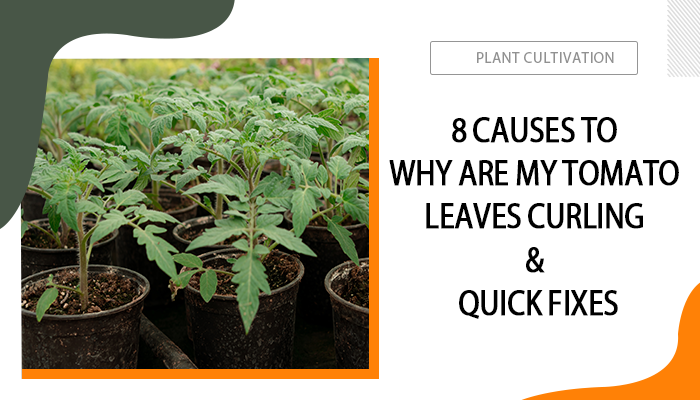Why Are My Tomato Leaves Curling & How to Fix
Tomato leaves curling up is definitely not a sign you would expect. These curled leaves may ruin the tomato growth and finally lead to an unsatisfying harvest. Why are my tomato leaves curling? For those bothered by the same question, this post will shed light on all possible reasons for tomato leave roll, plus effective solutions for each scenario.
Table of Contents
Underwatering Tomato Plants
Underwatering is often the biggest culprit to tomato leaves curling, especially for tomatoes grown in the pot. While water is an essential element to all plant growth, it is particularly crucial for tomatoes, as they require plenty of water and constant moisture to thrive and yield juicy tomatoes. Once underwatered, tomato leaves will start to crawl inwards to retain the limited water and prevent any further moisture loss, just to survive.
One fun fact is, overwatering your tomato plants is also likely to trigger the leave roll. However, the difference is that you’ll see other symptoms occur way before the tomato leaves start to curl, which we will not further address here.
How to Fix Insuccificent Tomato Watering
- Water slowly and consistently. Instead of flooding the soil all of a sudden, it’s a better approach to water your tomato plants constantly and regularly. By doing so, the soil gets fully penetrated and remains hydrated all the time. Click here to learn how often to water tomatoes.
- Water the soil, not the leaves. Although it’s emphasized a lot, many of you forget this tip in real-life practice. When watering tomato plants, you should aim for the soil base and not the top of the plants. Otherwise, you may find uneven dry spots in the soil and fungal diseases on the leaves.
- Water deeply to the root. A robust root network is fundamental for a flourishing, high-yielding tomato plant. And one method to promote this strong root development is through deep watering, generally around 6 inches in depth.
Extreme Environmental Stress
By saying extreme environmental stress, we are mainly talking about heat and overexposure to sunlight. Although tomatoes love warm conditions, extremely high temperatures - 90°F (32°C) and above can soon heat up their leaves and get them stressed. Consequently, the leaves twist and curl to conserve water.
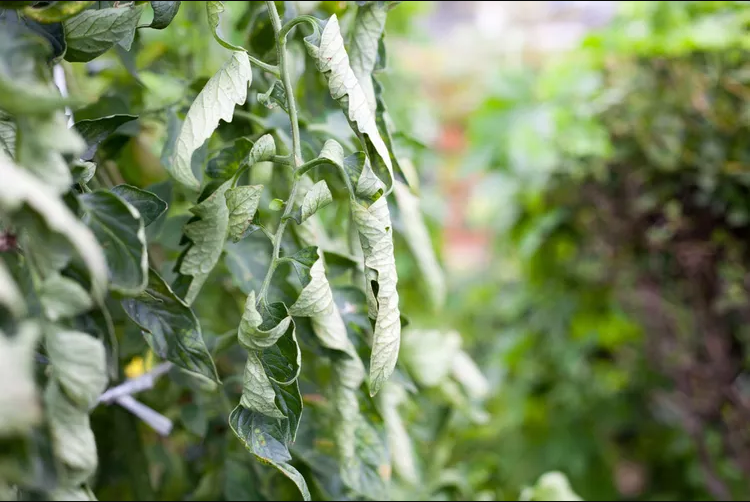
Similarly, sunlight during the summer includes exceptionally high UV rays. Intense and long-time sun exposure can soon get tomato leaves sunburnt. To protect themselves from exposing more surfaces to the rays, the leaves roll up.
How to Mitigate Environmental Stress
- Consider using a shade cover or net to filter intense sunlight while keeping the tomato well photosynthesized.
- By placing the plant in a sheltered area, you can avoid direct exposure to the sunlight on hot summer afternoons, somewhere around 2-3 o’clock.
- Keep the tomato hydrated, which we’ve explained above.
Incorrect Planting Time
Tomato plants that haven't been well hardened, a process that adequately acclimated the tomatoes from indoor to outdoor conditions, or those put into the ground too prematurely while the climate is still chilly, may experience leaf curling as a symptom of stress.
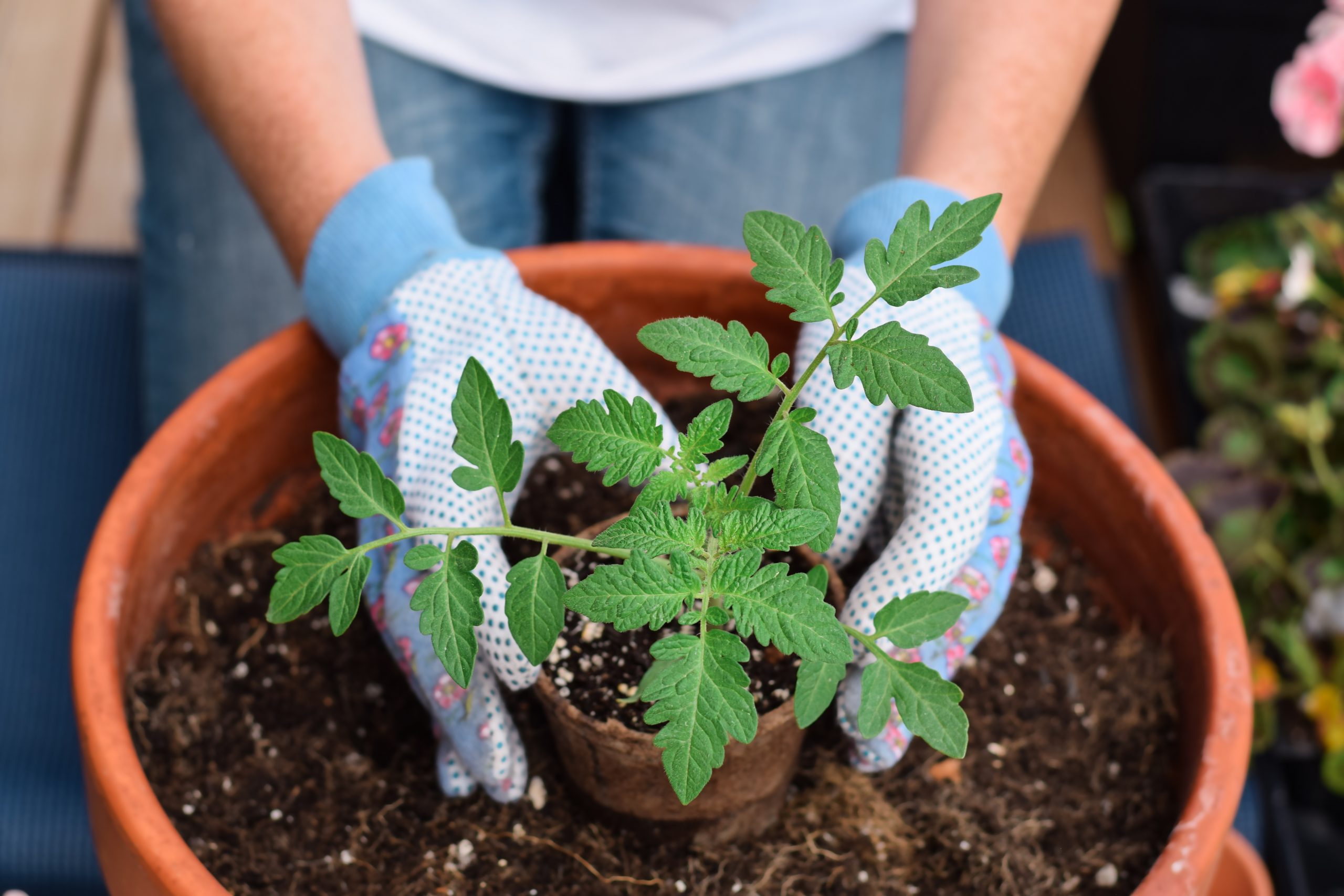
According to one report by Clemson University Cooperative Extension Home & Garden Information Center, tomato planted too early typically begins with the lower leaves curling upwards and then rolling inward towards the central vein. Despite maintaining a healthy green color, these leaves often become thicker and develop a leathery texture. Over time, this condition can spread to all leaves on the plant.
What Is the Right Time to Plant Tomatoes
It mainly counts on the temperature. In general, tomatoes prefer warm temperatures for both day and night, making late spring through early summer the most optimal time for planting in many regions. For reference, you can plant tomato seedlings when daytime temperatures reliably range from 70 to 79 degrees Fahrenheit and nighttime temperatures not dipping below a range of 61 to 65 degrees Fahrenheit.
Imbanlaced Nutrient
It makes great sense to use a balanced fertilizer that contains a good mixture of nitrogen, phosphorus, and potassium during the early stages of growth. The only thing is, as the plants grow, say, reaching the flowering stage, nitrogen is just no longer the most needed nutrient for them. If you keep adding the same fertilizer, chances are the tomato is absorbing too much nitrogen but too less phosphorus. As a result, instead of yielding fruits, the tomato plants get thicker, greener, and inward-curled leaves. Sometimes, you can also notice black spots on tomato leaves.
What Nutrient Do Tomatoes Need
As you can tell, the nutrients required for tomatoes can vary during different growth stages. By checking the chart below, you should know how to avoid tomato leaves curling by offering balanced nutrients.
|
Seedling Stage |
Vegetative Stage |
Flowering Stage |
|
|---|---|---|---|
|
Primary Nutrients |
A balanced mix of nitrogen (N), phosphorus (P), and potassium (K) |
Higher levels of nitrogen |
Lower levels of nitrogen but high levels of phosphorus and potassium |
|
Secondary Nutrients |
Calcium and magnesium |
Calcium and magnesium |
|
Excessive Pruning
Though controversial, some gardeners do constant pruning to increase yield and promote air circulation. If you are a fan of pruning tomato plants, possibly it’s the excessive pruning that leads to tomato leaves curling. The reason is quite simple - the plants choose to curl their remaining leaves as a kind of self-protection.
Furthermore, unnecessary pruning increases the plant's exposure to sunlight, making it more vulnerable to the previously mentioned heat-related issues.
How to Fix Excessive Pruning
To be fair, there’s no way to ‘fix’ an overly pruned tomato plant, after all, what’s done is done. Just leave it be and give the plant a few weeks to recover. By that time, it should grow normal leaves.
Viral Diseases
Tomato plants are susceptible to a variety of viral infections that can lead to leaf-curling symptoms, two of the most common ones are Tomato Yellow Leaf Curl Virus and Tomato Mosaic Virus.
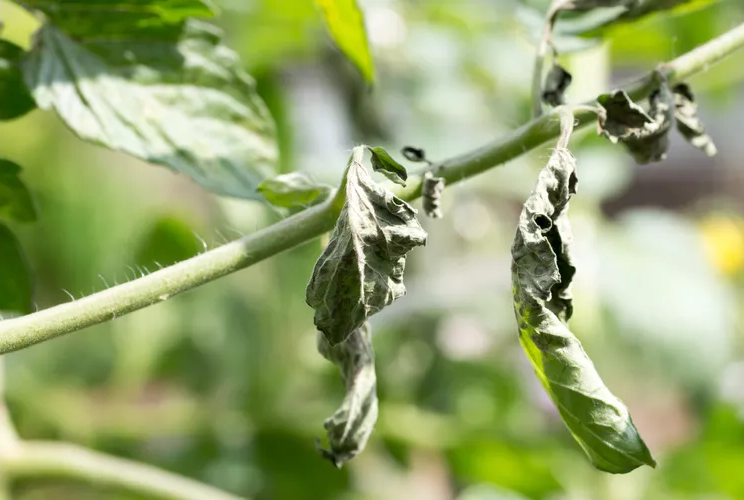
image source: Getty Image
- Tomato Yellow Leaf Curl Virus (TYLCV): This is one of the most common viruses affecting tomato plants and is typically transmitted by whiteflies. Infected plants show upward curling of leaves, yellowing, and stunted growth.
- Tomato Mosaic Virus (ToMV): Tomato plants infected by this virus usually present mottled green and yellow leaves which may be curled or distorted, and small new leaflets. The infected fruit tends to be brown inside.
How to Fix Tomato Virus Dieases
Unlike bacterial or fungal diseases, there are no chemical treatments that can cure a viral infection once a tomato plant is infected. You should remove the infected parts as soon as possible just to protect the remaining healthy ones.
Don’t get frustrated though, there is still something you can do to minimize the damage. Since the viruses are mainly transmitted by insects across the garden, you can place aluminum or silver-colored reflective mulches between rows to deter whiteflies. Obviously, the most effective way to stay away from viruses is to make your garden sterilized.
Herbicide Drift
Herbicides are chemicals used to control or eliminate unwanted plants, typically grass. When these chemicals are applied, particularly in a spray form, they can drift away from the targeted area and affect non-target plants on windy days. Some herbicides are particularly volatile, say, 2,4-D and Dicamba, which means they can vaporize and travel significant distances. When non-target plants get influenced, symptoms such as leaf curling occur.
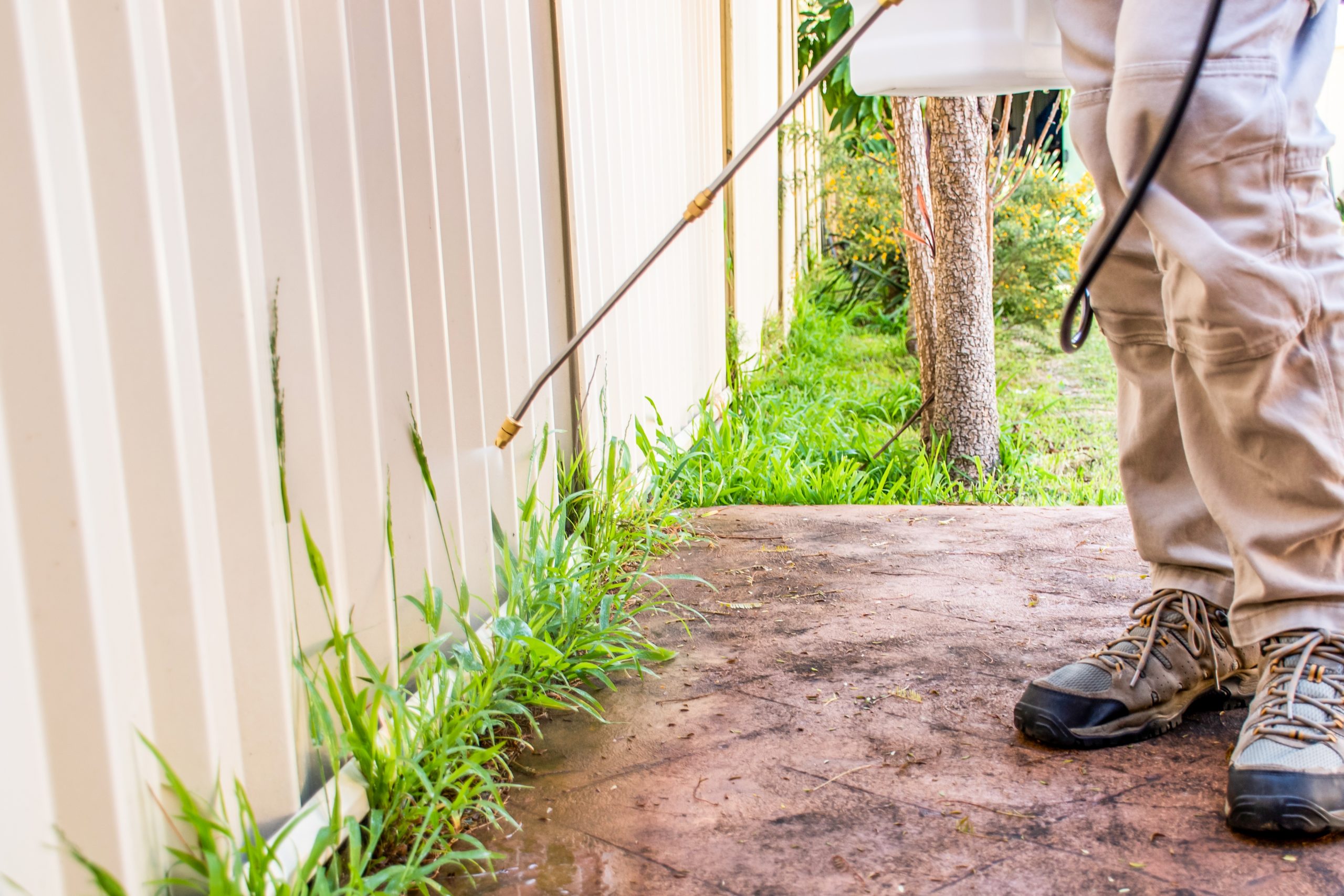
However, unlike leaves curled inwards due to stress, herbicide-affected tomato leaves are always twisted and curled downwards. In the meantime, not only the tomato but any other plants near the drifted area are showing similar symptoms. That is a big clue to herbicide exposure.
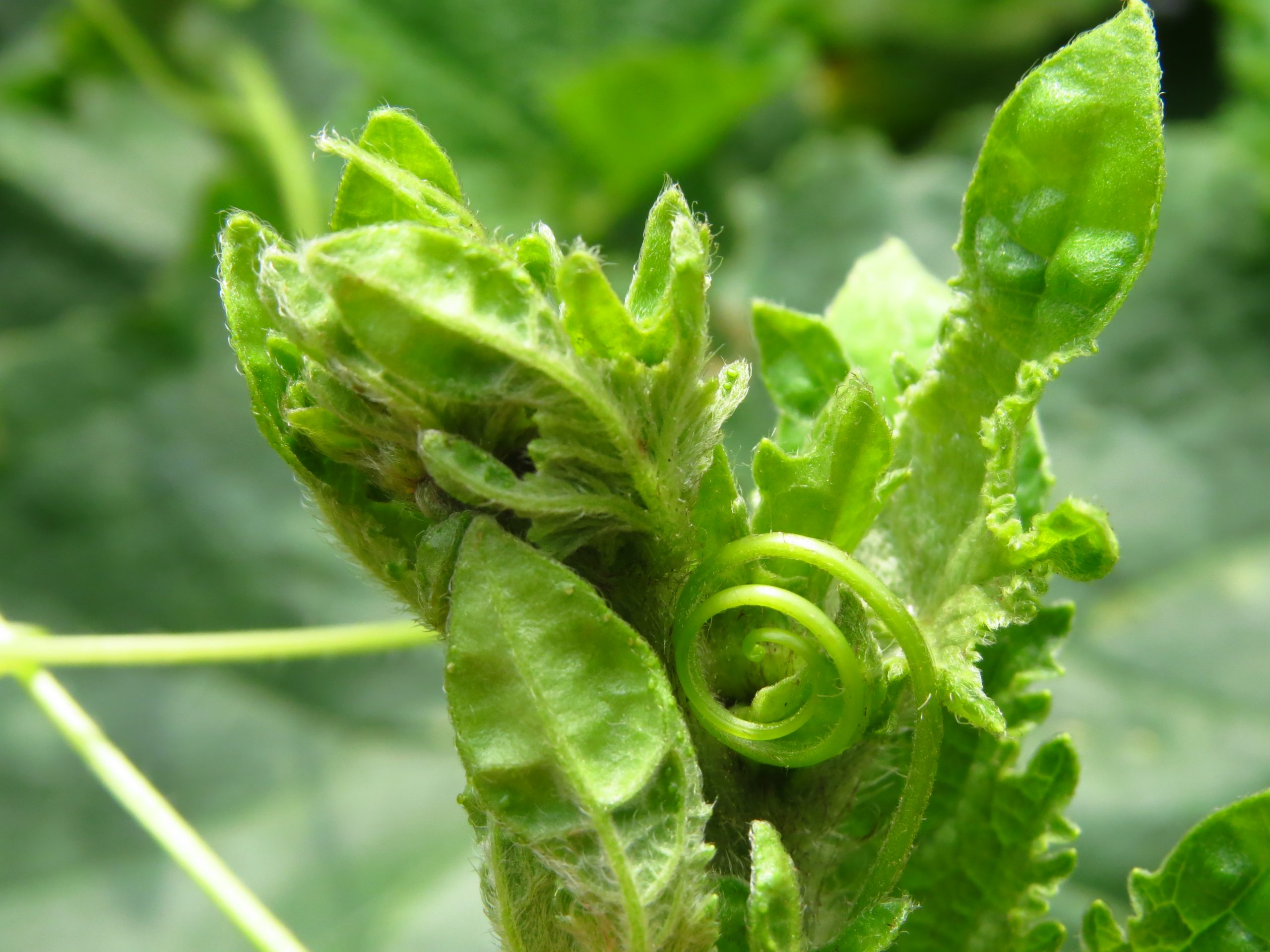
How to Avoid Herbicide Drift
Currently, there’s no way to recover tomato leaves damaged by herbicide drift. The only thing you can do is wait for new leaves coming out and see if things are getting better. However, you do have a list of practices to avoid herbicide exposure in the future:
- Check weather conditions: Avoid spraying on windy days, when the risk of drift is highest. Ideal conditions include low wind speeds and high humidity.
- Use low-volatility herbicides: Some herbicides are formulated to minimize vapor drift. Check the product label for this feature.
- Use proper nozzles and lower pressure: Using nozzles that produce larger droplets can minimize drift. Lowering the spraying pressure can also help.
- Adjust spray height: Keep the spray nozzles as close as possible to the target plants to minimize the distance that droplets have to travel.
- Physical barriers: Install physical barriers like windbreaks or tarpaulins to protect sensitive plants from potential drift.
Transplant Shock
Have you recently transplanted the tomato to a new place? Possibly, it’s the transplant shock that causes the tomato leaf roll. Whenever you move tomato plants to a different location, there's always a risk of damaging the delicate tomato roots. Once the root system is corrupted, you’ll see manifestations such as wilted or yellow tomato leaves, and tomato leaves curling.
How to Recover Tomato Leaves from Transplant Shock
Fortunately, mild cases of transplant shock are usually not something to concern. Similar to other environmental factors, a bit of patience is often all that’s needed. The plants should naturally recover on their own within a few weeks.
Conclusion
The issue of curling leaves in tomato plants is a multifaceted problem with various potential causes, ranging from environmental stresses and watering issues to more serious concerns like herbicide exposure and viral infections. Diagnosing the specific reason behind leaf curl is crucial for effective treatment and prevention.
FAQs about Why Are My Tomato Leaves Curling
How do you treat leaf curls on tomato plants?
- Identify the cause first—whether it's environmental stress, overwatering, or disease. For mild issues, simply adjusting care practices like watering can help. For viral issues, remove infected plants to prevent further damage.
Can overwatering cause tomato leaves to curl?
- Yes, overwatering can cause tomato leaves to curl due to root stress and reduced nutrient uptake.
What does it mean when tomato leaves curl up?
- Environmental stress: Hot, dry conditions can lead to leaf curl as the plant conserves water.
- Underwatering: Inadequate water can also lead to leaf curl as the plant tries to reduce water loss.
- Herbicide drift: Exposure to herbicides like 2,4-D can cause leaves to curl and twist.
- Viral infections: Diseases like Tomato Yellow Leaf Curl Virus can cause leaves to curl up.
- Transplant shock: Newly moved plants might show curling as a stress response.
- Nutrient imbalance: Deficiencies or excess of certain nutrients can result in leaf curl.
How do I stop my leaves from curling?
- Proper watering: Adjust your watering schedule according to the plant's needs to prevent overwatering or underwatering.
- Climate control: Provide shade or windbreaks to protect plants from extreme environmental conditions.
- Check for pests: Use insecticides or natural methods to control pests like whiteflies that can spread viruses.
- Use reflective mulches: To deter pests, place reflective mulches between rows.
- Transplant carefully: Take care when transplanting to avoid root damage, which can lead to leaf curl.
- Test soil: Regularly check soil nutrients and pH and amend as needed.
- Remove infected plants: If viral or severe herbicide exposure is the cause, you may need to remove and destroy the affected plants.


